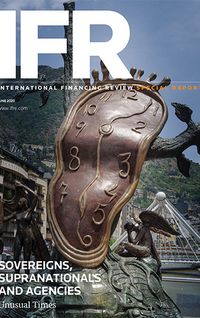Although Covid-19 stimulus means that government and semi-government issuance out of Australia has beaten all records, investors continue to flock to the Aussie curve.
When the Australian Office of Financial Management brought its A$19bn (US$12.2bn) 1% new 10-year bond to market in mid-May, it was the largest issue ever seen Down Under.
More to the point, the record-breaking book of A$53.5bn which was managed by ANZ, Citigroup, CBA and UBS, showed quite how much demand there currently is for Australian sovereign paper, not only from onshore but also from offshore investors.
Indeed, the previous record had come from the AOFM only a month previously with the sale of A$13bn 0.25% four-year paper that saw A$25.8bn of demand.
What is behind all of this issuance and all of this appetite for Australian paper?
“When I look at the market and what is driving the broad-based demand, a lot of factors are lining up at the moment,” said Craig Johnston, head of DCM syndicate, Australia and New Zealand, at Deutsche Bank, citing government need, domestic and international demand, a beneficial currency and a positive yield differential to offshore currencies.
The prime driver for all of this issuance is what Jeremy Zook, sovereign analyst at Fitch, calls the “historic level of stimulus that we’re seeing in Australia at the moment”.
The fiscal response to the Covid-19 pandemic in Australia has been significant with both JobKeeper and JobSeeker payments funded to support workers.
These stimulus measures are likely to make up around 10% of gross domestic product over the next couple of quarters and estimates suggest that the country’s funding needs have increased one and a half to two times.
Domestic demand is also there thanks to the Reserve Bank of Australia, which introduced a quantitative easing programme at the end of March and has helped with market liquidity. The central bank went out with a run rate of A$5bn of bonds per week which was later blended down to A$3bn a week.
“To date, the RBA has bought around A$50bn of government bonds. We have scaled back our purchases recently as conditions have continued to improve, and over the past week we have not purchased any bonds,” said Philip Lowe, governor of the RBA, speaking (virtually) at the FINSIA Forum in late May, adding that he was prepared to scale up these purchases again if necessary
“It is this kind of reassurance that investors have wanted. Even though the RBA bond-buying programme has slowed down, investors do have confidence that if we do get volatility, as we did see at the end of February and March, the reserve bank will be there to help facilitate the functioning of the market,” said one banker.
HOME AND AWAY
Paul White, head of capital markets at ANZ, pointed out where the domestic demand is coming from.
“[Quantitative easing] has helped the banks with liquidity and they are buying assets. Then you have fund managers sitting on a lot of cash who are looking for a home. They are quite conservative by nature, so are attracted by government bonds and liquidity. It is worth remembering that Australia is one of only a handful of Triple A rated sovereigns.”
But there is a growing demand from foreign investors. While they typically take only around 25% of the paper on offer, they accounted for just over 46% of the book for the recent AOFM deal. Bankers point out that interest in the paper is widespread, coming from central banks as well as from asset managers across the various regions in Asia, especially in Japan.
They are attracted both by the currency and the yield curve.
The Australian dollar had been at a fairly steady high of A$0.70 to the US dollar, which is where it was at the start of the year. Since then, it has come down, and although it briefly dipped as low as A$0.57, it has been trading fairly steadily in the low to mid-60s. This dynamic has led some accounts to use the bonds to hedge on a currency basis.
But more market players point to the yield curve. For the first time in a while, the Australian curve is trading at a higher yield than its US counterpart. The Australia/US spread is around 20bp at the moment.
“Demand for the AUD product remains strong, particularly out of Asia, as in terms of Australian rates, the 10-year government bond is currently at 0.86%, whilst you have the US 10-year Treasury bond at 0.66%,” said Cameron Lofstedt, vice president of DCM and syndicate at Bank of America.
“The Australian yield and credit curve is very steep when you compare it to offshore markets. So, where the yield pick-up is for offshore investors is particularly around the longer part of the curve,” he added, explaining why bond tenors have pushed out over the past couple of months.
STATES STEP IN
This trend has been particularly apparent with Australian semi-government issuance from the individual states, which has also been enthusiastic. Indeed, Western Australia, Northern Territory, New South Wales, Queensland, Victoria and Australian Capital Territory have all raised debt successfully over the past two months.
The market dynamics are apparent in the issuance from TCorp, the investment and financial arm of New South Wales. At the beginning of April, it brought the first such deal to the Australian primary market after the Covid-19 lockdown, which also happened to be the largest transaction of its type since 2011 from an Australian semi-government issuer, to raise A$3.2bn. It comprised a A$1.2bn 3.5-year floating-rate note at BBSW plus 39bp and a A$2bn tap of its 1% 2024s via joint lead managers CBA, Citigroup, UBS and Westpac. Neither tranche had especially long tenors.
It was followed in mid-April with several more deals in quick succession, including a new seven-year A$500m floating-rate note at three-month BBSW plus 55bp via Deutsche Bank and a €50m tap of its 0.609% 2050 Eurobond via Bank of America.
The states too are looking for funding for Covid-19-inspired initiatives and are keen to take advantage of the liquidity in the system. And from the perspective of the buyers, as one banker explained, “the spreads of semis to govvies is attractive, as well as the overall yield itself”.
But although there have been some 20-year private placements, a sign of returning normality for the public markets came from New South Wales when it issued a new A$450m 2041 bond and increased its 30-year Eurobond, taking the outstanding issue to €190m.
“The bond markets both domestically and offshore have experienced a period of instability as a result of the Covid-19 pandemic. Markets are now functioning better and have become far more stable,” said Fiona Trigona, TCorp’s head of funding and balance sheet, explaining her confidence in issuing longer.
Ratings agencies are not taking an especially dim view of the issuance. A higher debt-to-GDP ratio by definition leads to more pressure on ratings, but Fitch’s Zook has a measured outlook.
“The deterioration in Australia’s fiscal metrics led us to put the Triple A rating outlook on negative in May, but the magnitude is comparable with what we’re seeing in many other Triple As,” he said.
“The current government has had a strong commitment to prudent fiscal management and returning to surpluses and this is something that we see as having broad political consensus in Australia. A continued commitment to rebuilding fiscal buffers after this shock by putting debt to GDP on a downward trend would support the rating,” he added.
It looks as though this volume of supply is likely to continue for the foreseeable future.
“From an Australia perspective, the government has announced a clear stimulus package, which ultimately needs to be funded and I anticipate their funding profile will continue and not reduce by any considerable magnitude. However, the AOFM will provide further clarity on its issuance guidance in early-mid July,” said Chad Karpes head of DCM and syndicate at Bank of America.
Demand is likely to continue too. The only wild card, as with everything this year, is how the coronavirus continues to develop.
To see the digital version of this report, please click here
To purchase printed copies or a PDF of this report, please email gloria.balbastro@refinitiv.com
![]()




























